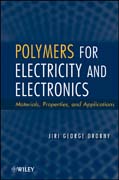
Polymers for electricity and electronics: materials, properties, and applications
Drobny, Jiri George
This book introduces readers to the fundamentals, basic principles, properties, and applications of electrical polymers. It provides the principles in an extended and accessible way, as well as including examples of state-of-the-art scientific issues. The book evaluates emerging technologies such as light emitting diodes, soft electronics, and conductive fibers used for smart clothing or electromagnetic shields, and explains the advantages of conductive polymers as well as their processibility and commercial use. The coverage includes problems for study with solutions within chapters on chemical and physical properties and basic concepts. INDICE: Preface. 1. Introduction. 1.1 Electric Charge. 1.2 Coulombs Law. 1.3 Conductors and Insulators. 1.4 Capacitors. 1.5 Dielectrics and Capacitance.1.6 Dielectric Polarizability. 1.7 Voltage. 1.8 Electric Currents. 1.9 Resistance and Resistivity. 1.11 Semiconductors. 1.12 Superconductivity and Superconductors. 1.13 Piezoelectricity. 1.14 Pyroelectricity. 1.15 Ferroelectricity. 2. Polymeric Materials. 2.1 Introduction. 2.2 Polymerization. 2.3 Molecular Weights and Molecular Weight Distributions. 2.4 Configuration. 2.5 Glass Transition Temperature and Melting Temperature. 2.6 Solutions of Polymers. 2.7 PolymerCompatibility. 2.8 Deformation Behavior. 2.9 Polymeric Foams. 2.10 Liquid Crystals. 2.11 Nanocomposites. 2.12 Commercial Polymers. 2.13 General Technological Characteristics of Polymers. 2.14 Processing of Polymers. 2.15 Adhesion andAdhesives. 3. Polymers as Electrical Insulators. 3.1 Dielectric Constants of Polymers. 3.2 Dielectric Relaxation. 3.3 Tangent of Dielectric Loss Angle. 3.4Dielectric Breakdown of Polymers. 3.5 Static Charges. 4. Specialty Polymers. 4.1 Intrinsically Conductive Polymers. 4.2 Ferroelectric Polymers. 4.3 Thermotropic Liquid Crystal Polymers. 4.4 Ionomers. 5. Commercial Polymers in Practical Electrical and Electronic Applications. 5.1 Polymeric Materials Used As Insulators. 5.2 Wire and Cable Technology. 5.3 Other Applications of Polymers andPolymer Systems. 6. Applications of Specialty Polymers. 6.1 Applications of Conjugated Polymers. 6.2 Applications of Ferroelectric Polymers. 6.3 Applications of Liquid Crystal Polymers. 6.4 Applications of Ionomers. 6.5 Lithium Ion Polymer Batteries. 7. Testing of Electrical Properties of Polymers. 7.1 Introduction. 7.2 Individual Tests of Electrical Properties. 8. Current Trends and Developments. 8.1 Molecular Electronics. 8.2 Intelligent Material Systems. 8.3 Other Developments and Trends. Appendix I. Typical Values of Electrical Properties of Selected Polymers. Appendix II. Electrical Properties, ASTM Test Methods, and Specifications. Appendix II. Basic Electrical Tests ASTM and Corresponding International Standards. Appendix IV. Nobel Prize 2000 for Chemistry, Title Page. Acronyms and Abbreviations. Glossary. Bibliography.
- ISBN: 978-0-470-45553-1
- Editorial: John Wiley & Sons
- Encuadernacion: Cartoné
- Páginas: 344
- Fecha Publicación: 02/02/2012
- Nº Volúmenes: 1
- Idioma: Inglés
